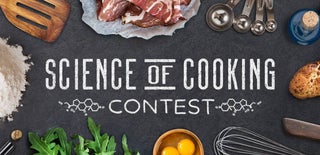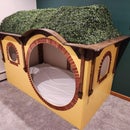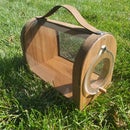Introduction: Ultimate Guide to Cheesecake
I like to cook/bake and I really like cheesecake. These are two traits that my wife is quite happy with. Because of this I have tried many different cheesecake recipes but they tend to be so far apart that I often don't get to compare them to know what I like about each one. Not too long ago I came across The Ultimate Guide to Chocolate Chip Cookies which varied the ingredients in cookies to see how it effected them. This gave me the idea to do the same thing for cheesecake. I looked around at a lot of different plain cheesecake recipes to see how the ingredients varied to determine what variations I wanted to do.
I ended up with six different variation that I wanted to try. These Included:
- Using less eggs
- Using more eggs
- Adding sour cream
- Adding heavy whipping cream
- Adding flour
- Adding cornstarch
I didn't want to add other flavors as I believe theses ingredients would set up a good base that you could then build upon any way you wanted.
Notes:
I decided to sous vide these cheesecakes to cook them. If you have that capability then I would recommend it.
I also decided to make these in 4 oz. mason jars. I chose to do this so that I didn't have to make 7 full size cheesecakes. These are also great to make for a party so that everyone can add the toppings they prefer.
If you aren't making these sous vide or in small mason jars then the recipe portion of this will have to be modified to the cooking method of your choice but how the ingredients effect the final result will still apply.
Step 1: The Basic Recipe
Now that I had the variations it was time to start with the basic recipe that would be my control. Between all the recipes that I found there they all revolved around the following ingredients:
- 4 (8 oz.) packages of cream cheese [room temperature]
- 1-1.5 cups sugar
- 1tsp - 1Tbsp vanilla
- 4 eggs
- Some recipes also added a little lemon for flavor.
For this study, I used 1 cup of sugar and 1 tsp of vanilla. The amount of sugar, vanilla, and lemon are all dependent on your preference.
Step 2: Making the Crust
I tried to keep the crust pretty basic as well. I probably could have done without a crust because I was testing the variation in the cheesecake but since this was going to make a lot of cheesecake I wanted to be able to enjoy the extras with a crust.
The crust recipe is as follows:
- 4 Tbsp melted butter
- 1 cup graham cracker crumbs
- 1/4 cup sugar
Steps:
- Melt the butter and then mix in the graham cracker crumbs and sugar
- Spoon into our mason jar/pan
- Press into pan (I used a spice container covered in parchment paper due to the size of the small mason jars)
- Bake at 370 degrees F for 10 minutes (Optional but helps the crust stay together)
Step 3: Making the Cheesecake
Now it's time to make the cheesecake. To save me from making a Ton of cheesecake, I cut the recipe in 1/4 and then divided that again in half to then add the additional ingredients. This resulted in 2 mini cheesecakes of each kind. If you did the full recipe, it would result in about 18-20 mini cheesecakes.
Here is the recipe I used for the control group:
- 4 (8 oz.) packages of cream cheese [room temperature]
- 1 cups sugar
- 1tsp vanilla
- 4 eggs
Steps:
- Heat water bath to 176 degrees F
- Mix sugar, vanilla, and cream cheese until smooth
- Add the eggs and mix until blended. Try not to over mix
- Add the cheesecake mixture to the mason jar/pan
- Tighten jar lid with minimal pressure. Air must escape during cooking
- Insert jars into water bath
- Cook for 1 hour and 30 minutes
- Remove from water bath and let them cool down to room temperature
- Chill in fridge for at least 4 hours
- Enjoy
Step 4: Control Group
This was a good classic cheesecake taste. relatively thick and mildly sweet. Using 1 cup of sugar would be good if you plan on topping it with some type of sweet topping. If you are going to have it plain then you could increase it to 1 and a half cups of sugar if you like it pretty sweet. Definitely a good cheesecake.
Step 5: Less Eggs
For this one I used 2 eggs instead of 4. This resulted in a much denser/thicker cheesecake while keeping the same taste as the control group one. If you like a really thick and dense cheesecake then just reduce the amount of eggs.
Step 6: More Eggs
For this one I used 6 eggs instead of 4. This resulted in a smoother, creamier, and lighter cheesecake then the control group one. If you want a smoother and lighter cheesecake then you just need to increase the number of eggs used.
Step 7: Sour Cream Added
For this one I added one cup of sour cream. This resulted in an even creamier texture than the one with more eggs but also gave it a slightly tart taste. It didn't have as strong of a sweet sugary taste as well. This one was good by itself and would probably be good with a lemon or lime flavoring or topping.
Step 8: Heavy Cream Added
For this one I added 3/4 cup heavy whipping cream. This resulted in an even lighter cheesecake then the sour cream and it gave it a milky taste. This one seemed to be the smoothest of all the variants. This was also very good by itself and would probably be good with either chocolate or a fruit topping like strawberry or cherry.
Step 9: Flour Added
For this one I added 2 Tbsp of flour. This resulted in a VERY thick, by far the thickest, cheesecake but it also had a very strong flour taste that made it taste less sweet. It also gave it a more cake like texture that sort of had a chalky texture to it. It was my wife and my own least favorite of all of these. If you really like that taste then this would be the one for you but if not then I would stay away from flour as a thickener as the flour taste comes out too strong. If you did want to use flour then I would change it to 1 Tbsp instead of 2.
Step 10: Corn Starch Added
For this one I added 2 Tbsp of cornstarch. This resulted in a cheesecake that was just as thick as the one with less eggs and didn't effect the taste like the flour one. It did result in a more cake like texture as well. If you want to add something to thicken your cheesecake then I would definitely recommend this over flour to thicken it.
Step 11: Final Thoughts
After tasting all of these, multiple times, I had some final thoughts and my recommendations. If you have your own cheesecake recipe then hopefully this can help you if you would like to modify it based off of how the different ingredients effect it.
Thickness:
- Making it thicker: I did not like the flour or cornstarch ones as much because it changed it from more of a smooth and creamy texture to a slightly more cake like texture. If that is what you like then I would definitely recommend cornstarch over flour. If you want it thicker but want to keep it more creamy then I would suggest using less eggs.
- Making it lighter: If you don't like the thick and heavy cheesecake then I would recommend adding more eggs if you want to keep the classic taste or adding sour cream or heavy whipping cream if you like how those change the taste.
Taste:
- Sour Cream: This gave it more of a tart taste. This could be utilized if you are going to make a flavored cheesecake where a more tart taste would help the other flavors. I think it would work really well with a lemon or lime flavored cheesecake.
- Heavy Whipping Cream: This gave it more of a milky taste. Like the sour cream, this could be used well if you were doing a flavored cheesecake. I think this would go really well with sweeter type fruit (strawberries, cherries, peaches) and/or with chocolate/caramel.
In the end I have come to realize that I will now be varying my cheesecake base depending on the type of cheesecake I want to make. The standard recipe is great if you are doing a topping bar but the other ingredients can definitely enhance the cheesecake if you are doing a specific flavored one.
Hopefully this will help you out to really nail down the base to your next cheesecake that you can then add all sorts of other flavors to.
Cheesecakes are great. Good Luck.

Runner Up in the
Science of Cooking













